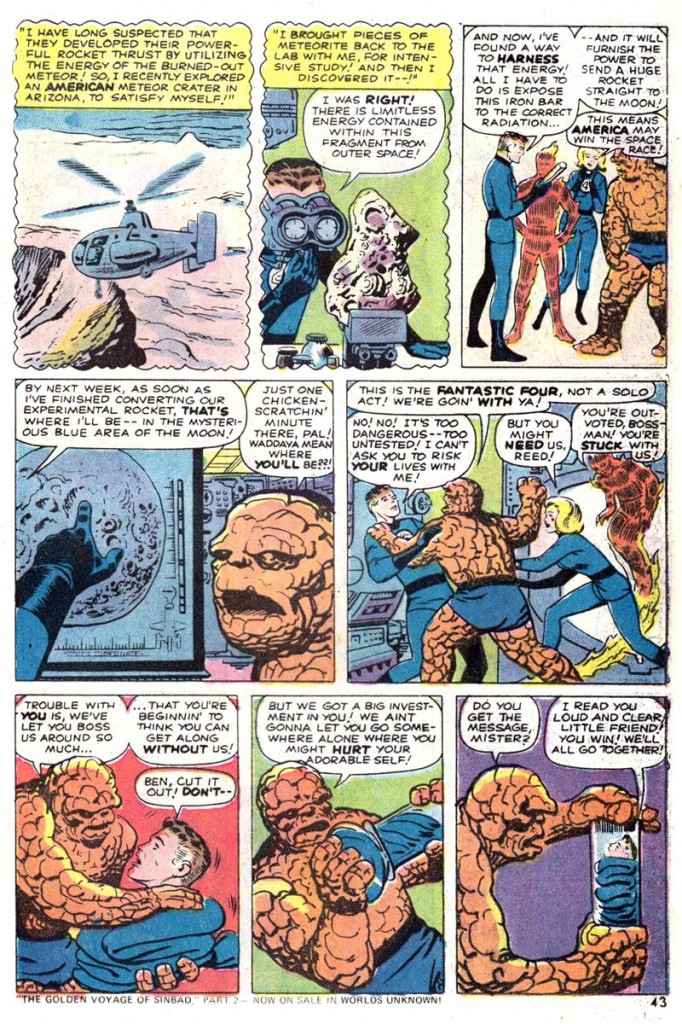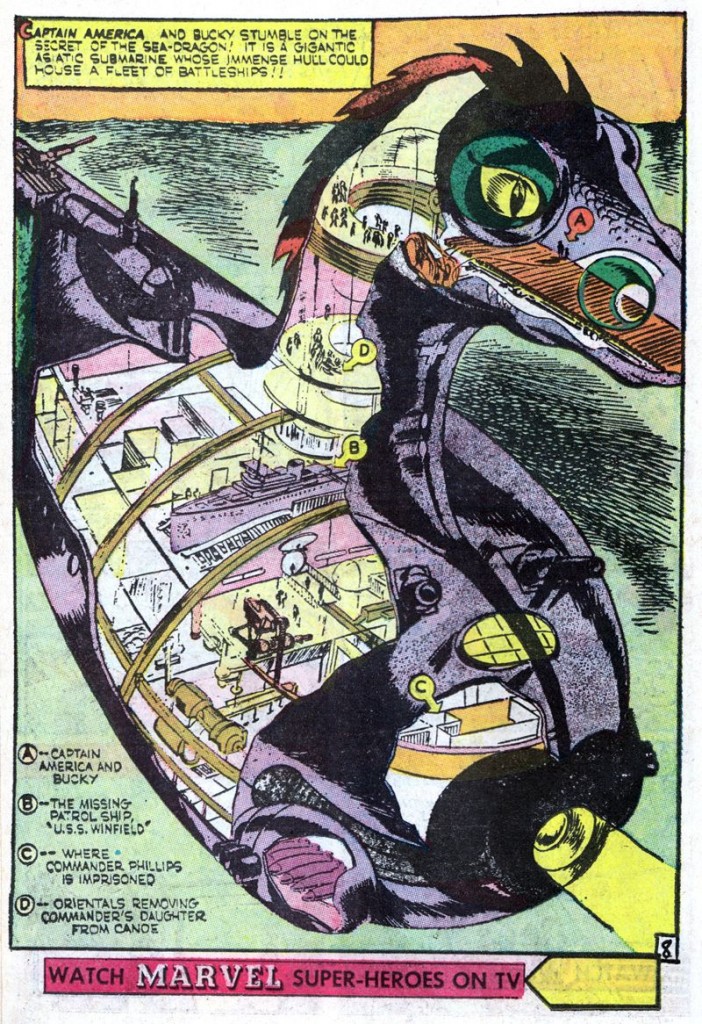This issue reprints the original X-MEN #14 (1965), “Among Us Stalk the Sentinels”. Kirby continues the hand-off of art duties to Werner Roth, doing layouts for Roth (working under the Jay Gavin pen-name) to finish. Colletta inks this time around.
Recovering from their battle with the Juggernaut, Professor X gives the X-Men some vacation time. It would prove to be short lived respite, as anthropologist Bolivar Trask starts whipping up the anti-mutant hysteria. My favourite bit of the issue is the newspaper article with artist renditions of Trask’s predictions of the mutant overlords.
The Professor arranges a TV debate with Trask, where Trask unveils his Sentinel robots meant to protect humanity. The robots quickly turn on him, so Professor X sends out a mental alert.
Hank and Bobby at the Coffee A-Go-Go (complete with beatnik poet) are the first to respond, just after most of the Sentinels depart with Trask to create more Sentinels leaving one guard. They battle him until Cyclops (who ran into an example of the anti-mutant sentiment Trask riled up) arrives, and then the Sentinel mysteriously collapses. Jean and Warren arrive shortly after (with Warren having a brief encounter with the other Sentinels on the way), as Professor X examines the fallen Sentinel and gets an impression of their headquarters, as well as mentioning that the Sentinel said something about “Master Mold” as it collapsed (oddly we’re not actually shown that). The X-Men drive up to the location the Professor saw, and find an empty field which suddenly rises to reveal a fortified structure that fires at them.
This is a surprisingly attractive issue. Roth seems to maintain a lot of the Kirby elements from the layouts, and Colletta’s inks seem more compatible with his pencils than most. The Sentinels don’t look quite as menacing as they should, but are a nice design. More importantly, this run of the book would solidify the themes that would carry the book for decades to come.
By the way, this is one of those annoying instances where Marvel reprinted the story without noting that “Jay Gavin” was a pen-name, so Roth’s name doesn’t appear at all, despite the fact that newly typeset credits were pasted on the originals.
The original cover is printed as a pin-up in the back, as drawn by Kirby and Wallace Wood. I never noticed before, but it seems to be flipped left-to-right (or at least the Sentinel has a backwards “1” on its chest).
Published 1995


![X-men - The Early Years #14 [1995]](http://kirbymuseum.org/blogs/kirby/wp-content/uploads/sites/8/2005/03/X-men-The-Early-Years-14-1995-683x1024.jpg)
![Mister Miracle #9 [1972]](http://kirbymuseum.org/blogs/kirby/wp-content/uploads/sites/8/2005/03/Mister-Miracle-9-1972-685x1024.jpg)
![Mister Miracle #9 [1972]b](http://kirbymuseum.org/blogs/kirby/wp-content/uploads/sites/8/2005/03/Mister-Miracle-9-1972b-693x1024.jpg)
![The Incredible Hulk Special #3 [1971]](http://kirbymuseum.org/blogs/kirby/wp-content/uploads/sites/8/2005/03/The-Incredible-Hulk-Special-3-1971-708x1024.jpg)
![Marvel Milestone Edition - Fantastic Four No. 1 [1991]](http://kirbymuseum.org/blogs/kirby/wp-content/uploads/sites/8/2005/03/Marvel-Milestone-Edition-Fantastic-Four-No.-1-1991-697x1024.jpg)
![Thor #170 [1969]](http://kirbymuseum.org/blogs/kirby/wp-content/uploads/sites/8/2005/03/Thor-170-1969-693x1024.jpg)
![Super Powers #2 [1984]](http://kirbymuseum.org/blogs/kirby/wp-content/uploads/sites/8/2005/02/Super-Powers-2-1984-667x1024.jpg)
![Black Panther #8 [1978] Black Panther #8 [1978]](http://kirbymuseum.org/blogs/kirby/wp-content/uploads/sites/8/2005/02/Black-Panther-8-1978.jpg)
![Marvel's Greatest Comics #72 [1977]](http://kirbymuseum.org/blogs/kirby/wp-content/uploads/sites/8/2005/02/Marvels-Greatest-Comics-72-1977-681x1024.jpg)

